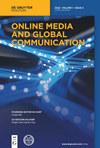“计算转向”:“跨学科转向”?新闻研究中文本作为数据方法的系统综述
引用次数: 0
摘要
在新闻研究中应用自动化内容分析的可能性包括,例如,机器学习来识别新闻报道中的主题或通过自动化方法测量新闻传播。但是到目前为止,计算方法是如何应用的呢?传播科学的“计算转向”(computational turn)会带来什么后果,尤其是涉及到跨学科的领域?本文在系统回顾文献的基础上,总结了自动化内容分析在新闻学研究中的应用。结果表明,传播科学家越来越多地使用该方法,这是传播科学方法论跨学科性的另一个指标。然而,几乎没有证据表明理论跨学科性的增加:依赖于计算方法的研究并没有越来越多地参考其他学科的理论。在实际的跨学科方面,例如合作,我们的学科并没有变得更加跨学科。相反,我们发现一种有利于技术学科的转变。至少到目前为止,通信科学的“计算转向”不应该等同于“跨学科转向”。本文章由计算机程序翻译,如有差异,请以英文原文为准。
The “computational turn”: an “interdisciplinary turn”? A systematic review of text as data approaches in journalism studies
Abstract Possibilities of applying automated content analysis in journalism studies include, for example, machine learning to identify topics in journalistic coverage or measuring news diffusion via automated approaches. But how have computational methods been applied thus far? And what are consequences of the “computational turn” in communication science, especially concerning interdisciplinarity? Based on a systematic literature review, this article summarizes the use of automated content analysis in journalism studies. Results illustrate an increasing use of the method by communication scientists, as yet another indicator of methodological interdisciplinarity in communication science. However, there is little evidence of an increase in theoretical interdisciplinarity: Studies relying on computational methods do not increasingly refer to theories from other disciplines. With respect to practical interdisciplinarity, for instance collaborations, our discipline is by no means becoming more interdisciplinary. Instead, we find a shift in favor of technical disciplines. At least up to now, the “computational turn” in communication science should thus not be equated with an “interdisciplinary turn.”
求助全文
通过发布文献求助,成功后即可免费获取论文全文。
去求助
来源期刊

Online Media and Global Communication
Communication, Media Studies, Internet Studies, International Studies, International Relations-
自引率
0.00%
发文量
0
期刊介绍:
Online Media and Global Communication (OMGC) is a new venue for high quality articles on theories and methods about the role of online media in global communication. This journal is sponsored by the Center for Global Public Opinion Research of China and School of Journalism and Communication, Shanghai International Studies University, China. It is published solely online in English. The journal aims to serve as an academic bridge in the research of online media and global communication between the dominating English-speaking world and the non-English speaking world that has remained mostly invisible due to language barriers. Through its structured abstracts for all research articles and uniform keyword system in the United Nations’ official six languages plus Japanese and German (Arabic, Chinese, English, French, Russian, Spanish, Japanese, and German), the journal provides a highly accessible platform to users worldwide. Its unique dual track single-blind and double-blind review system facilitates manuscript reviews with different levels of author identities. OMGC publishes review essays on the state-of-the-art in online media and global communication research in different countries and regions, original research papers on topics related online media and global communication and translated articles from non-English speaking Global South. It strives to be a leading platform for scientific exchange in online media and global communication.
For events and more, consider following us on Twitter at https://twitter.com/OMGCJOURNAL.
Topics
OMGC publishes high quality, innovative and original research on global communication especially in the use of global online media platforms such as Facebook, TikTok, YouTube, Twitter, Instagram, WhatsApp, Weibo, WeChat, Wikipedia, web sites, blogs, etc. This journal will address the contemporary concerns about the effects and operations of global digital media platforms on international relations, international public opinion, fake news and propaganda dissemination, diaspora communication, consumer behavior as well as the balance of voices in the world. Comparative research across countries are particularly welcome. Empirical research is preferred over conceptual papers.
Article Formats
In addition to the standard research article format, the Journal includes the following formats:
● One translation paper selected from Non-English Journals that with high quality as “Gems from the Global South” per issue
● One review essay on current state of research in online media and global communication in a country or region
 求助内容:
求助内容: 应助结果提醒方式:
应助结果提醒方式:


